Mistakes new boaters make – are there many? How can you ensure you don’t make them too? Read this article to avoid some of the common pitfalls so to flatten your learning curve quickly.
1. Saying “over and out” on the VHF radio.
When speaking over the VHF radio only one person can speak at a time. The person speaking holds down the button, talks, and transmits. When they are done speaking they take their finger off the button allowing the other person to transmit. To signify that one speaker is done speaking, the procedure is to say over meaning ‘over to you now.’
Kim: My plan is to head to Marigot tonight. What about you? Over.
Lynette: Oh, that’s great. We are headed to Marigot too. Shall we do sundowners on our boat at 5 pm? Over.
Kim: Yes, that sounds great. Where do you intend on anchoring? Over.
Out, however, means ‘I’m hanging up – good bye’. If you say, ‘over and out,’ that means that you’re waiting for the other person to come back to you and hanging up/ending the transmission at the same time.
This is how you end your conversation:
Lynette: We are anchoring on the west side of the bay in front of the blue shack. Over.
Kim: Great. We will see you around 5. Out.
For some reason, Hollywood is known for having characters say ‘over and out’ which is totally incorrect and makes no sense. If you’re speaking over the VHF there could be a handful to hundreds of people listening. If you say ‘over and out’ let it be known that you will be snickered at!
Also check out, How To Make A VHF Radio Call.
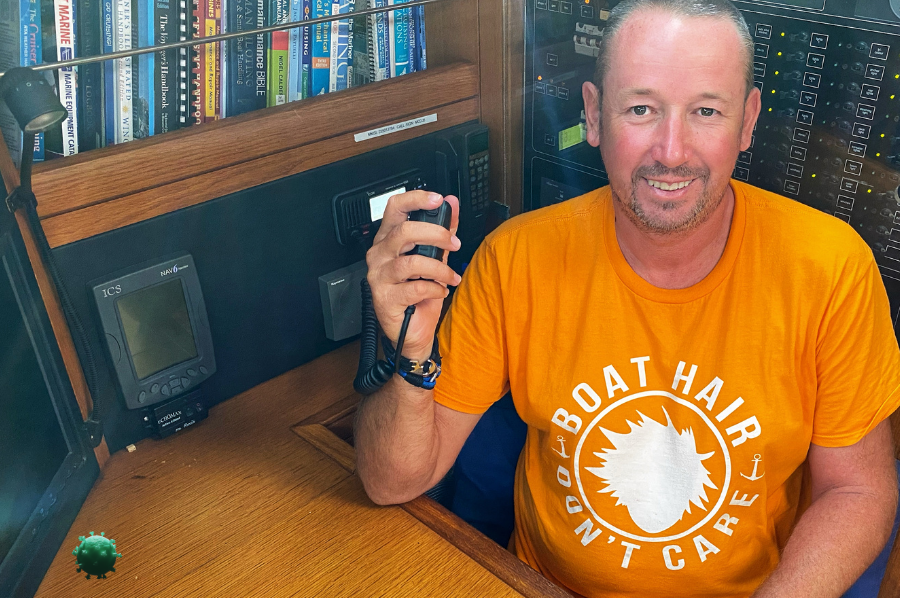
2. Making one or several of these anchoring mistakes.
Crashing the anchor over the bow roller.
When dropping or raising the anchor, including the long anchor arm, it has to make quite a drastic transition either dropping over the edge of the bow roller or be hoisted up to the top of the deck.
The objective of this task is to do it in a controlled manner ensuring the anchor is not thrashing about crashing into the furler or anything else in its way. To do this task without making loud crashing noises it’s best to tap the windlass controller slowly ensuring a soft anchor launch or landing.
Anchoring without reversing while the rode or chain feeds out.
In order to reduce the likelihood of your anchor getting fouled it’s imperative to drop the anchor until it just touches the seafloor and then allow the wind or use the engine to get the boat going backward SLOWLY.
Often, it’s enough to just put the boat in reverse for a few seconds and then pop it into neutral. The aim is to get your rode or chain to feed out backward along the seabed ensuring it won’t tangle.
The reason this needs to be done slowly is so that the anchor doesn’t drag and pull up the seafloor (possibly killing animal dwellings) AND so that when the anchor digs in and the chain is straightened the windlass isn’t pulled out of the deck.
Slow and controlled is the name of the game.
Not backing down on the anchor.
Once the anchor and anchor chain has been fed out the anchor needs to be ‘set’. Setting the anchor is an imperative task to reduce the likelihood of dragging. To set the anchor the helmsperson goes in reverse, once all the chain is out, SLOWLY to ensure the anchor is bedded in and holding.
Once the anchor is proven to be holding, the helmsperson increases the revs and slowly pulls back more and more to ensure that, indeed, the anchor is set.
If the anchor is not set and the boat is not holding in one place, it’s often a good idea to pull up the chain and anchor and try again in another location. It can take several attempts to get the anchor to hold. In one anchorage in Grenada, known for having bad holding, we had to try 10 different places before we found sand.
Using the windlass to bring in anchor chain without the support of the main boat engine.
The anchor winch, or windlass, is an expensive bit of kit! It’s not designed to pull up the anchor chain AND pull the boat to the anchor.
In order to reduce the strain, and instances of wear and tear, the helmsperson needs to drive over the anchor rode or chain while the person on anchor-duty pulls in the chain as it slackens.
Learn how to anchor during a Sailing Lifestyle Experience ==> Get available dates, prices, and full details here!
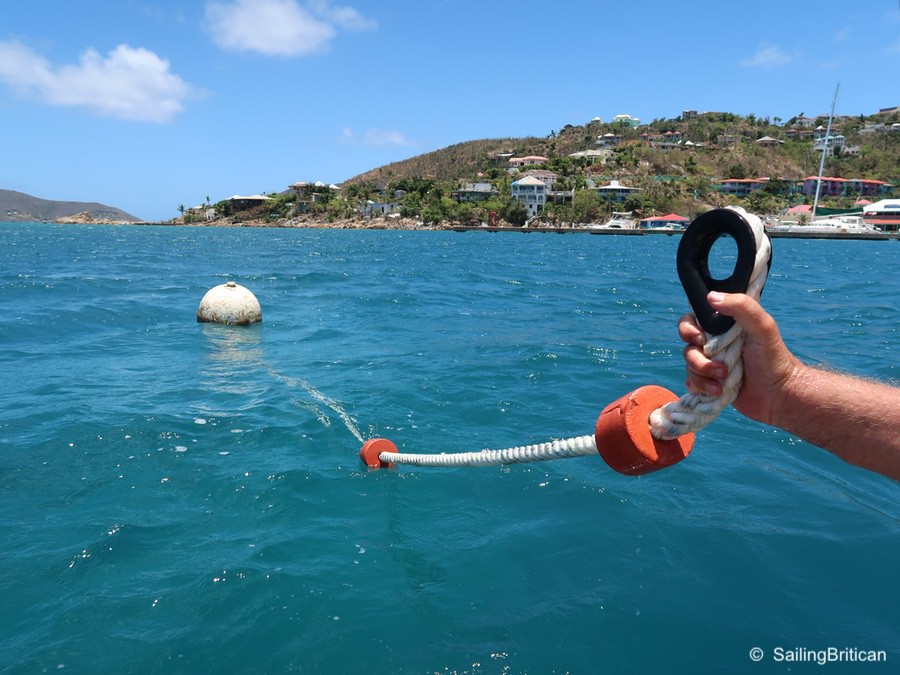
3. Making mistakes on how to correctly tie onto a mooring ball.
Using only one line to tie onto a mooring ball.
To tie onto a mooring ball a line from the forward starboard (right side of the boat) needs to go from the cleat to the ball and back onto the same cleat. So, the line is tied onto the cleat, fed out to the mooring ball, and then returns to the same cleat. This is repeated on the port side (left side of the boat). Both lines need to be the same distance to the ball and back so they share the load.
Taking one line from the starboard cleat, feeding it through the mooring ball, and then over the port side cleat is a massive no-no. Doing it this way will increase the chance of chaffing – the line will rub back and forth on the mooring ball connection. Furthermore, it’s one point of failure and not two.
When using two lines, both going and coming from the same side of the boat, the movement that causes chaffing is reduced, if not eliminated. Furthermore, if one line fails (breaks/chaffs) there’s another line for backup.
Extra tip: Don’t assume mooring balls are in a good state. Once you’re on a ball, dive in and check out what you’re attached to. In some cases, you’ll find it’s not sufficient. You can also back down on mooring balls to ensure they’ll hold you. Furthermore, use your anchor alarm, even for mooring balls, because they can fail. An alarm will let you know if you’re drifting away.
Extra, extra tip: Insurance companies often won’t insure you if you come off a mooring and end up on the reef. They’ll tell you to go after the mooring ball provider. The mooring ball provider almost always offers mornings to use at your own risk.
Using the mooring ball painter as the line to tie to the boat.
Mooring balls come in different sizes, shapes, and set-ups. Usually, a mooring ball is a floating ball connected to a large concrete block or screw located along the seabed. Additionally, there is another line, a painter, that is used to pick up and tie onto. The painter either has a loop or an eyelet. Some inexperienced sailors have been known to use the painter as the connection point to the boat. They pull up the painter and tie it or loop it around a cleat. This is not the correct way to use a mooring ball.
If you’re interested in the procedures on how to anchor and pull up a mooring ball, check out Anchoring & Moorings – Look Like A Pro From Day One
Learn how to anchor and do moorinb balls during a Sailing Lifestyle Experience ==> Get available dates, prices, and full details here!
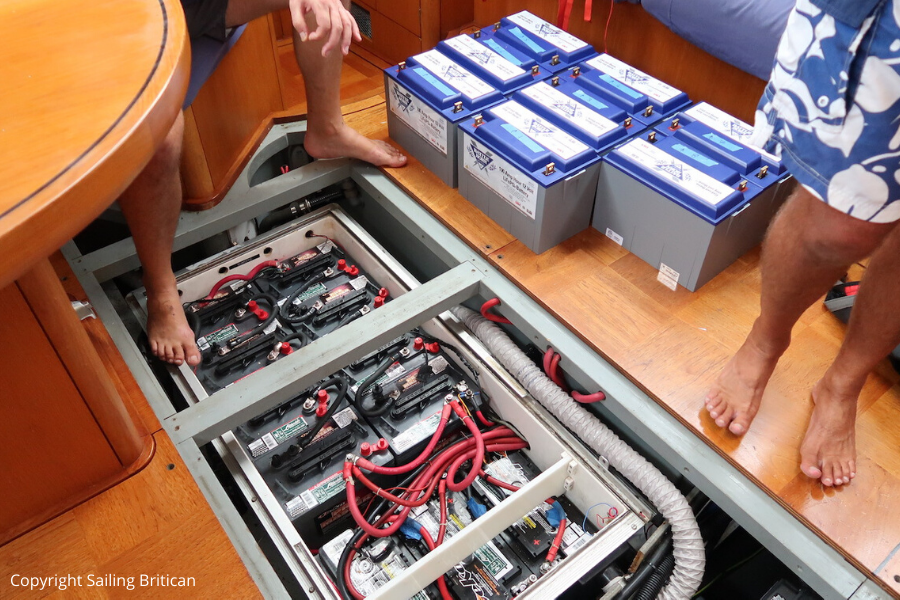
Here’s a photo of our Lithium Battery Install
4. Having lead-acid batteries and not checking/adding water to them periodically.
Some batteries need to be watered! Many new boat owners discover this fact after they’ve failed to water the batteries and are destroyed. Make sure you know what kind of batteries you have and if they need routine attention. Furthermore, the water used must be distilled water. Using water from the tap will also destroy the batteries.
Make sure to also check out The Beginners Guide To Marine Boat Batteries. Keep reading for more mistakes new boaters make…
5. Failing to bring your own beer and a snack to pass when invited for sundowners.
When invited to enjoy sundowners (drinks at sundown) on a neighboring cruising boat, it’s customary to bring your own drinks. They can be either alcoholic or non-alcoholic. Most cruisers have a small cooler bag that they’ll carry housing their drinks and glasses. Any cans or bottles are returned to the cooler bag and not left with the boat that is hosting.
You’ll also want to bring a snack to share. Something as simple as a bag of potato chips is fine or if you want to be a hit, bring a homemade dip or some kind of delicious appetizer.
It’s important to make sure you reciprocate and invite others over to your boat for sundowners too. Also, check out my article, How To Fit In As A New Cruiser.
6. Thinking there is only one correct way to do a task.
Sailing is a very old hobby and profession. Old salty sea dogs and schools like the Royal Yachting Association (RYA) and the American Sailing Association (ASA) have set opinions on how to do things the ‘right’ way.
The issue is that there are often many correct ways of doing the same task. Keep an open mind, review alternative approaches to doing a variety of tasks, and choose what works best for you. You don’t have to subscribe to one sailing school or the other – make up your own mind as to what is right for you as you gain more experience.
As a side, even the terminology in sailing isn’t universal. People around the world call different parts of a boat different names. Regarding tasks, the RYA teaches a different way to tie onto a cleat than the ASA. Do they both work – yes? Is one better than the other? Perhaps? It’s up to you to determine which right way is the right way for you.
Learn how we do a variety of tasks ruing our Sailing Lifestyle Experiences ==> Get available dates, prices, and full details here!
7. Spending too much money in the first few months/year.
If the boat you purchase is safe and seaworthy hold back on spending any money on it. Take it out and sail it for a few months first. Doing so will enable you to truly know what you really need. Most new boat owners buy stuff that they think they need only to find out that they should have spent their money more wisely.

8. Failing to create routine checks and service schedules.
A boat is not a car. You can’t simply take it in for service every few months or rely on a red light telling you that something will go wrong soon. Furthermore, you can’t just pull over to a service station, or call AAA to get assistance.
On a boat, the engine can fail, the rigging can come down or a thru-hull leak can turn into a disaster. Every day, week, month and before every passage, there are set checks and services to do. By performing set routines and checks you’ll be far more likely to find problems or prevent issues before they become disasters.
If you don’t already have my Checklists for Sailors guide, check it out here!
9. Getting work done while away from the boat.
Many marinas and boatyards provide overpriced and shoddy work and that’s if they do any work at all. If you’re paying for four coats of antifoul to be painted on, you need to be there and visually ensure four coats go on. This goes for all work done on a boat.
Furthermore, if you’re present, the likelihood of things getting done increases drastically.
10. Getting a colored hull.
My favorite color for a hull is navy blue. I think it looks so smart. The price to keep in looking good is, however, very steep. Before buying a boat with anything painted get a quote on how much it costs to repaint it and when the repaint job will be required. If you’re happy with that cost, which will add almost no value to the boat, then you’re going into the purchase with your eyes wide open.
Same thing goes for a teak deck! Keep reading for more mistakes new boaters make…
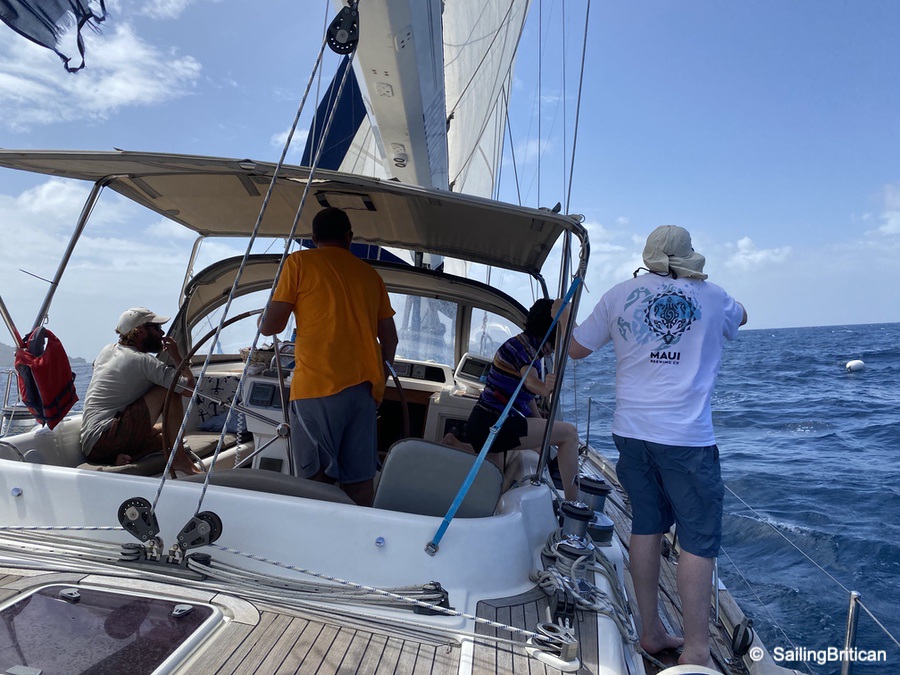
Us doing a MOB drill saving our fender named, Jimmy
11. Not fully understanding all the safety systems, equipment, and procedures.
When you head out to sea you can’t call 911 and get help within minutes. At times, help could take hours and even days. If caught in a storm it’s possible that help can’t come at all.
Sailing and the sailing lifestyle is massively rewarding and enjoyable. Emergencies, however, do happen, and when they do you need to know how to react.
Before going out to sea it’s imperative that you know about all your safety equipment, what it does, and how it works. Furthermore, it’s key to practice drills such as Man Overboard or abandon ship so that if it happens you are prepared. Keep reading for more mistakes new boat owners make.
Learn how to create a safe boating environment during a Sailing Lifestyle Experience ==> Get available dates, prices, and full details here!
12. Doing a MAYDAY incorrectly.
A MAYDAY is an emergency procedure used internationally as a distress signal in voice-procedure radio communications.
There is a set way to do a MAYDAY. When it comes to a MAYDAY it’s a life or death situation. Not knowing how to use the VHF, set off a DSC alert, or not having a template to read from could end in delays. Make sure to have a MAYDAY template, with your boat details already filled in, next to your VHF so you know how to be quick, efficient, and accurate.
Check out our Sending A MAYDAY checklist here.
Practice throwing a bouy overboard and rescuing it with a MOB procedure during a Sailing Lifestyle Experience ==> Get available dates, prices, and full details here!
13. Being overconfident.
Confidence is key with sailing. Gaining real confidence comes with experience and experience is often the result of many failures. With sailing, and perhaps all of life, no matter how great we are at something things can change. Different factors can be thrown into the mix that throws us off guard. It’s often when we think we have things perfected that the Universe proves us wrong. Be confident but don’t ever think your pooh doesn’t smell.
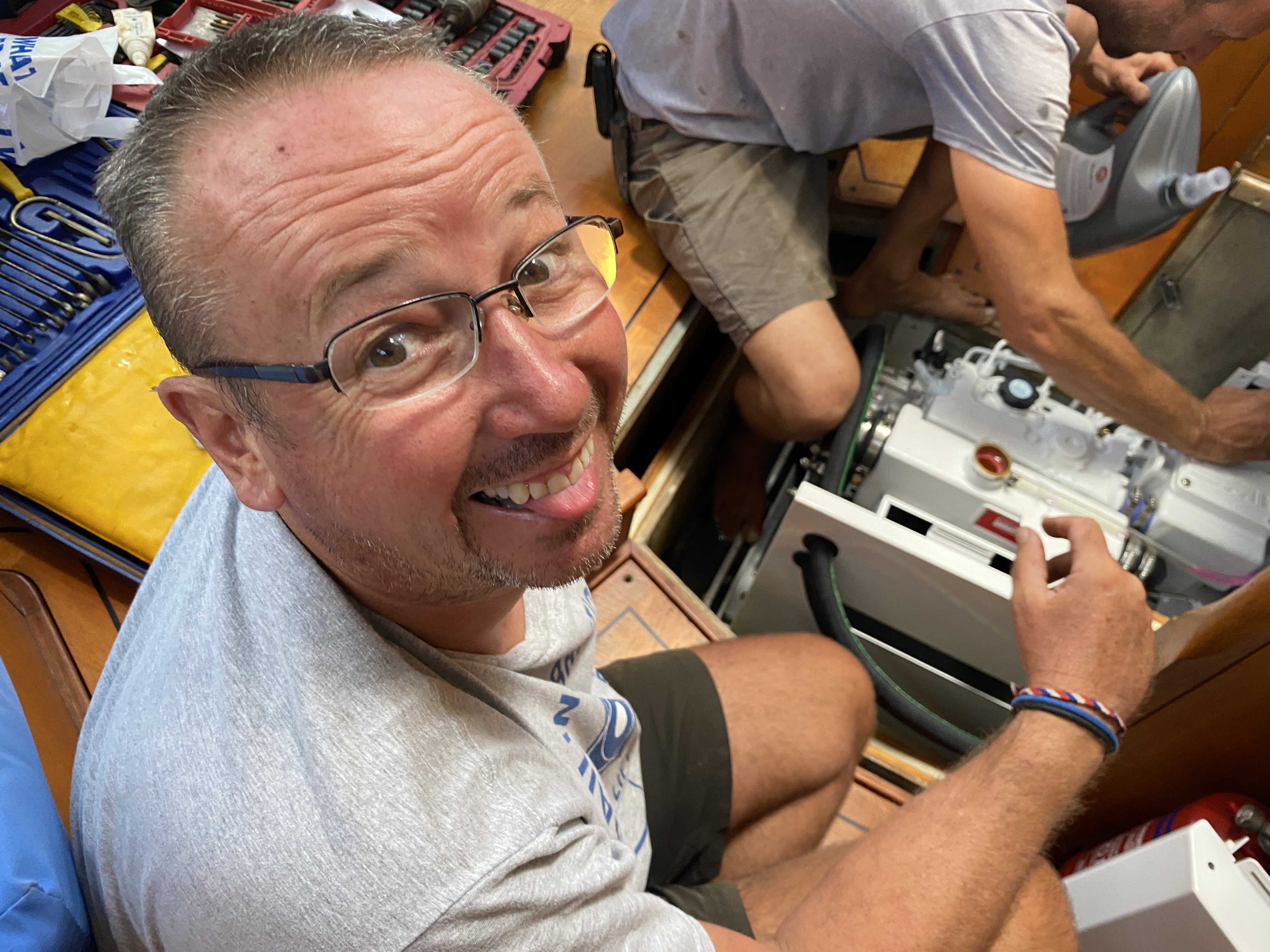
14. Not servicing your own equipment.
When you first start out, it’s nearly impossible to service everything. It took us years to truly get on top of things. What we did, however, was watch every time our engines or outboard were serviced. We watched when our winches were taken apart, greased, and put back together. Same for pumps, filters, motors, and anything that required us to pay someone to help us with.
We didn’t learn from technicians because we want to be cheap and do it ourselves. Nor did we watch them to make sure they actually did that job (although that is always a good idea). We watched so that if we’re in the middle of the sea, with no one around, we might be able to fix things ourselves.
I’ve seen countless boats incur huge bills because they overheat at sea, call a tow, and then pay for an emergency fix when it was something they could have easily done themselves. Changing the impeller is a good example. When our impeller goes the engine overheats. Changing an impeller is not difficult once you’ve done it before.
When starting out you might not be able to service all your equipment but make it a priority to learn about your mission-critical systems. Keep reading for more mistakes new boat owners make…
Learn how to service a marine diesel engine, watermaker, winches, and more during a Sailing Lifestyle Experience ==> Get available dates, prices, and full details here!
15. Making the boat a project rather than learning to sail.
You see this all the time. Someone decides to get into mountain biking. They spend thousands on the bike, the gear, and the clothes. And then the bike ends up in the garage not being used.
Many new boater owners think that spending a year repairing and renovating a boat is part of the sailing game. What usually happens is that the boat finally gets finished, and the boat owner takes the boat out and realizes that he/she likes renovating things and not actually sailing. The boat is then sold at a loss because boats don’t appreciate!
If you want to renovate something buy a house. At least you’ll have more of an opportunity to get a return on your time and money invested.
So…I mentioned the ‘sailing game’ above. Buying a new boat will require you to repair, service, and routinely fix things. It’s already a project. The sailing game, however, is to actually gain a benefit from all the fixing you have to do – it’s to SAIL and discover new destinations.
16. Mistakes new boat owners make – not getting adequate training on your own boat.
The quickest way to learn how to sail and maintain a boat is to hire someone to show you how to sail your own boat. Most experienced cruisers that we know, when they upgrade to another boat, hire a captain to practice maneuvering in tight spaces for a few days.
Every boat drives differently and driving a boat is nothing like a car. When you stop the boat, you have seconds before it starts moving again (wind or tide will help you with that).
In some cases, the previous owner will take the new owner out for a day to a week. This experience is invaluable! And what about your first long passage – consider hiring a captain to go with you. That way you learn how things work and it’s always reassuring to know what’s normal and what’s not.
17. Having a bad experience and quitting.
Some new boaters have read all the books and watched all the YouTube channels. They know the theory but when they actually take their boat out they realize that theory and real life are very different.
Leaving a dock, entering a marina, anchoring in a busy bay, sail trimming, and approaching a mooring ball are not learned instantly. A multitude of factors has to be weighed in addition to getting a feel for it.
Several new boaters go out, mess up, and quickly call it a day. Become a confident sailing cruiser so you don’t have a bad experience. Check out our Sailing Lifestyle Experiences ==> Get available dates, prices, and full details here!
More mistakes new boat owners make – carry on reading.

18. Insisting on being right rather than learning how to grow (Couples communication/teamwork)
When first starting out sailing it can be difficult for things to go correctly. A potentially huge weak spot is good communication between couples or families.
A scenario that plays out often is the husband at the bow of the boat yelling at the top of his lungs (to be heard) and the wife at the helm screaming back. Loud voices start out for one purpose (being heard) and end up causing elevated feelings. Things go wrong, or not quite right, and each partner expresses why they were right and the other was wrong. It’s no Bueno.
To avoid communication problems it’s often a good idea to get headsets so yelling is not needed. Or do what Simon and I do – we only use hand signals while anchoring or mooring.
Another good practice to get into is to discuss what went right and what went wrong in an effort to change how you do things next time.
Also see Cruising Couples Communication Tips.
19. Planning a long passage for an initial sailing experience.
After sailing for over eight years I still don’t like long passages. Contrary to common belief, most cruisers don’t like them at all. Children really don’t like them. Why? Long passages are long, they’re often very boring, many people don’t quite feel very well (a degree of seasickness), sailing at night can be scary the first few times…and when squalls hit it can be frightening.
Long passages take you out on open seas. Not being able to see land can cause some people concern. And large sea states are scary if you don’t know what ‘normal’ is.
Cruisers like sitting at anchor enjoying the anchorage or getting off the boat and exploring whatever island they are near. The passage to the island is often a means to an end.
Now don’t get me wrong, some people do like to sail. But what you typically find is one person likes to sail and the other isn’t too keen. Almost all the cruiser friends and family I know there’s at least one member of the family that suffers from seasickness. Why do they do it? Because the lifestyle and the end destinations are amazing.
Getting back to the mistake that new boaters make. Buying a boat, getting it ready to take out to sea, and then making your first passage a long one is very risky. Even if things go perfect the chances are that it’s not enjoyable for everyone. In many cases, it can be downright traumatic.
Although it takes more time, an alternative approach is to take the boat out for short small trips for a while before planning a long passage. Learning how to maneuver with the engine, get the sails up, sail at different points of sail, passage planning, weather routing, anchoring, and getting a mooring ball are all things that really need to be practiced way before ever considering a long passage.
Check out our special PASSAGE EXPERIENCES on offer ==> Get available dates, prices, and full details here!
And the final mistake new boat owners make is…
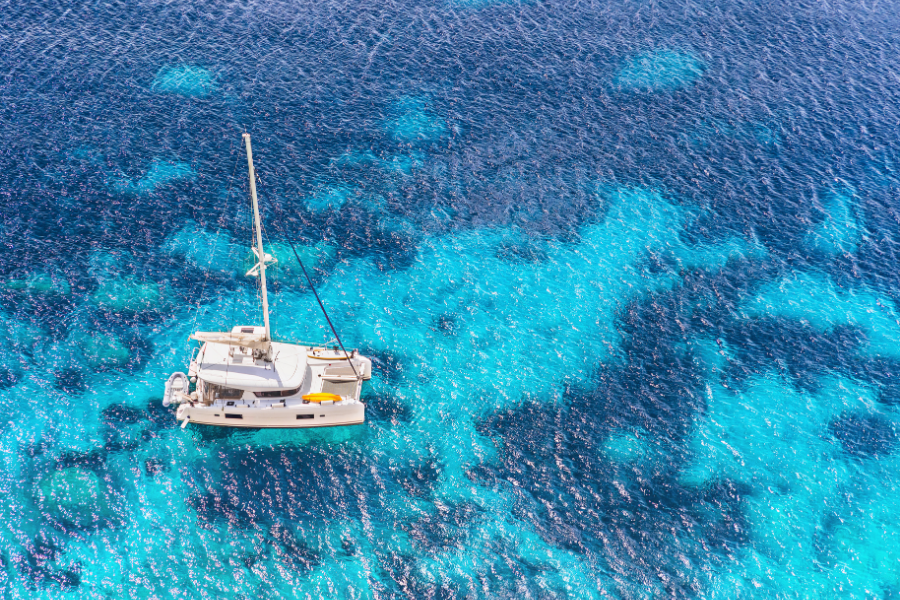
20. Thinking cats are better than mono’s or vice versa
Dare I broach this topic under the category of mistakes new boat owners make? I’ll be quick about it. There are pros and cons to both cats and monohulls (and I should include trimarans now too?). If you talk to a cat salesperson, read cat forums, or speak with cat owners you’ll get one perspective. If you talk to a mono salesperson you’ll get a different perspective. To truly make up your own mind (and not be brainwashed one way or the other) it’s a good idea to try them both out and get the sales pitch for both sides. Neither is right or wrong…it’s whether one is right or wrong for you.
As I’ve said for years, you don’t know what you don’t know. If you’ve made any of these mistakes don’t beat yourself up about it. How do you think we know about them? Yep – most of these mistakes we made when we first started out.
The learning curve to becoming a sailing cruiser is massive. What I try to do through my articles, educational videos, sailing, and boat ownership guides, and even our week-long liveaboard sailing charters is to highlight areas that you may not know about so that you now know 😉
What am I missing on common mistakes new boaters make?
Please leave your comments below and remember that if you want to speed up your learning curve drastically, apply for one of our Sailing Lifestyle Experiences ==> Get available dates, prices, and full details here!
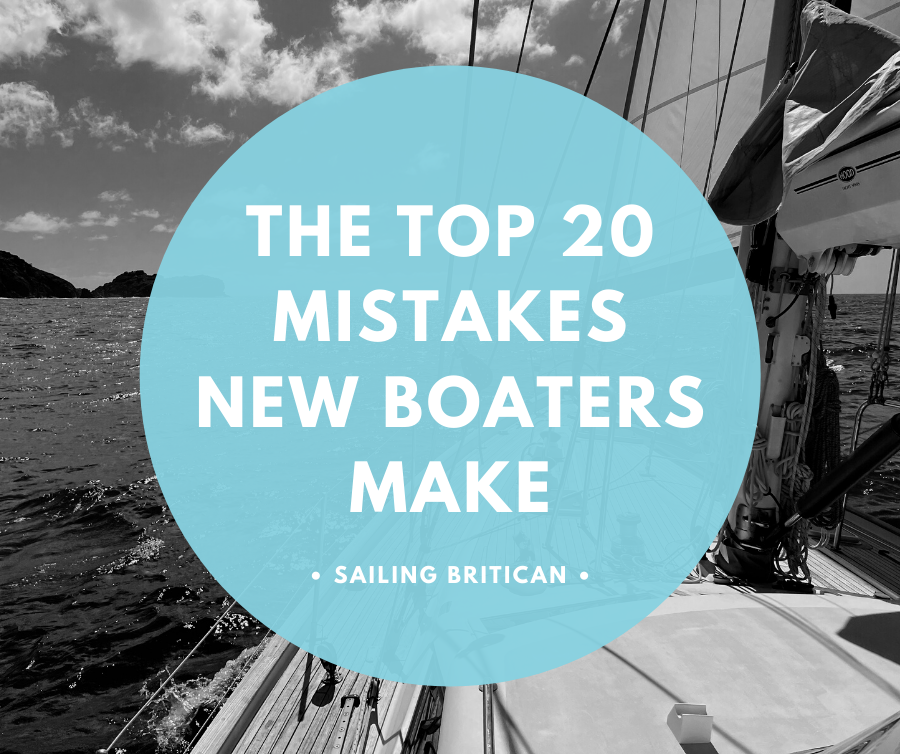
Neglect to bring in a fishing line prior to mooring.
Did that happen to you this past week?! Yes – we’ve done that a few times. We’ve also had our dinghy painter go into the prop too! Thanks for sharing. Kim
How about “Not knowing how to charge your batteries” and killing them by overcharging, undercharging and just plain draining them down too far too often. This would be in addition to not adding water to your lead acid batteries.
Anchoring too close or not realizing that the first person in an anchorage has to be avoided.
Good list!
Great additions Dixon! Yes – If you don’t understand power consumption and battery maintenance it can be a disaster. And yes, anchoring too close is a good one. Thank you for your comments. Kim
Great read. Nice post, Kim
Thank you Ken 😉
Not rigging a boom preventer when sailing a downwind course.
That’s a very good one Isaac! It’s certainly not uncommon to see new boaters do accidental gybes. On small boats, it’s not too bad but we’ve done it twice on Britican and it’s horrific. On one of our accidental gybes, we did have a preventer. The boom did cross to the other side and the preventer bent our safety railing but it wasn’t too bad. If it wasn’t for the preventer it could have been way worse. Thank you for the addition 🙂 Kim
Not wearing head gear if the boom is swinging – not realizing how dangerous that is. À diabetic captain low on blood sugar can overlook dangers like this or at least that’s what happened to me one time.
Yes – knowing how powerful and dangerous the boom is is a good one. Thank you for sharing Brian. K.
The preventer should run from the other side of the boat… then you won’t bend your stanchans
Not paying attention.
I suppose that can be said for new and old sailors alike. Hehehehe. Thank Hal. Kim
Not running your engine for 20 minutes at a dock after a service person has been in your engine room. Our engine died in a channel waiting for a bridge to open after leaving the dock in a hurry.
YEP. Been there. Done that. In Trinidad, we left the dock after our engine was fixed only to find it was leaking all over the place. Luckily we made it back before overheating. As a general rule, we turn our engine on way outside an anchorage to ensure it’s running well before entering. Same with leaving an anchorage. We turn it on about 20 minutes before lifting the anchor or taking the lines off a ball. It’s usually in the first 10 minutes or so that you’ll know something is wrong. Thanks for sharing Bob. Kim
Tightening jubilee clips with a regular screw driver instead of a jubilee clip driver or small socket wrench.
“Hopping about” the boat over confidently in a marina – forgetting for a moment that the laws of stability still apply.
Rushing to finish a job – especially one you haven’t done before.
How many times I wished I had a friend around to tell me to “slow down” before I broke something or hurt myself – not that they would. I’m a seasoned professional mariner so they all assume I know better – but a boat isn’t a ship: – and sometimes I forget that 🙂
Oh, and folding boarding ladders *cough*
All good mistakes to consider Luke. Thank you for sharing. Kim
Not knowing the rules of the road.
Thinking you have right of way.
Then knowing you have right of way but it’s better to give way .
Knowing your sound signals
And the very big one now….. knowing that sailing with sails up doesn’t mean you have right of way all the time.
And the best one is knowing which part of the World you are in for IALA cardinal marks , Region A or B
All excellent contributions Mark. I’m sure you’ve dealt with all these situations many times. Smiles, Kim
Zero inverted stability: the boat will always go back into “upright” position after a turtle sideway roll.
E g GB/UK pilot boats does. (not any “cat” boats does). – Long keel: if the keel-beam is under the propeller(-s) and rudder (-s), then there are some extra protection. – Flashing stobe light in the mast-top isn`t standard, but might be good to have under/in certain conditions (Extremely rough weather where there are many commercial ships e g). -Every fastening point should be strong enough to hold the weight of the whole boat. – Expencive boat: maybe x-ray to make sure the manufacturer has built it according to specification. – Do you have to have 3 “different” compasses to cover all oceans? – Echosounder…fine…why not a foreward looking one? – A boat should be strong enough to take a 100 feet wave at full force. – Bon Voyage…have a nice one!
Hey Karl – I’m hoping that new boaters don’t experience a turtle sideway roll! I surely never have and hope I never do. Lots of contributions here. Thank you for posting. Kim
When setting or backing down on your anchor use a short strop attached to the chain to a forward cleat so any strain is taken on the cleat not the windlass.
Extend or replace the strop with a snubber after setting.
On Rum Truffle we have a spliced loop to 2ft of line to an anchor claw for this purpose.
Ps strop also used when breaking out the anchor.
Great additions Mark. I often pull back on the windlass knowing that I really shouldn’t be doing that. I don’t want to put the bridal on and find it’s dragging only to take it off again. Having a quick snubber would do the trick. Thank you. Kim
Not having spare fuel and spare parts on board for common problems. For example, you mention changing an impeller to solve an overheating problem – to do that, at sea, requires a spare impeller in a location where it can be found. Spare fuel seems like such a no brainer but there is a least one video regarding some new sailors who trusted their fuel gauge rather than keeping a log of engine time along with knowing the burn rate of their engine. Best to do both.
I might have also added not having paper charts on board and knowing how to use them if the electronics fail.
But the top 20 that you list are good ones!
Great additions Nello. Just yesterday a boating friend of ours ran out of fuel. Luckily he had some on board but running out is not fun. Thank you for your contributions. Kim
Some good advice,
If you have your boat antifoul with extra costs just have 4 colours, they will get the drift why,
Life jackets as a skipper you are responsible for the safety of those on board, if it’s not comerciail it’s not easy to say to to the swimming champion of the world put a jacket on, but if he falls overboard bangs his head that will not make any difference, and getting a knocked out adult out of the water even with the right tackle is not easy and rarely practiced, something to do in the bay as an exercise just to show how difficult it is in perfect conditions, people drown just falling of pontoons,
Teak decks never scrub along the grain always scrub across the grain, otherwise you will halve the life of your deck,
Thank you for your additions Toni! Smiles, Kim
A good list Kim, and you did mention the need to get an experienced captain or the former owner to advise you when you first sail the boat. Unless the new boater already has good experience I would broaden this to the need for some training, at least to day skipper level for the skipper and mate, and maybe competent crew for other family members. The cost of an instructor and an exam would be money well spent. In UK there is no legal requirement for qualifications before sailing away, all you need is cash to buy the boat. Charter companies insist on qualifications, for good reason.
I particularly liked your point about shouting being a mistake. Hand signals and silent docking reduce stress and reassure neighbours that you know what you’re doing.
Yes Mike, I couldn’t agree with you more. A combination of training and experience onboard your own boat are key. I remember being in Cowes once when a large motorboat came in and docked in front of us side-to the pontoon. There was a captain (teaching the new owner) and the family. The captain asked the owner to take care of the back warp. He tied the line to the cleat on his boat and the cleat on the dock but didn’t know enough to pull the slack in. Simon helped out. Later that night the captain said that if we saw this boat to go the other way! The owner had lots of money but absolutely no boating sense. I do find it incredible that people can buy boats and have no idea how to operate them. Heck – isn’t there a need to have a forklift license? If you need a license for that why not a boat? Thank you for your contributions. Kim
Good, no great advice for newbies.
Thank you Cedric. Smiles, Kim
Excellent Kim. Your experience is always interesting. For myself, I have crossed oceans, many nautical miles in both fair and vile weathers but always on mega powered yachts as a Chef although I have a wildly out of date Day Skippers RYA ticket. Even on massive yachts, a big sea is a big sea!! That’s why I like listening to you guys, because I want to get hold of my sailing yacht before I’m too old!!!! I have to come and ‘try before I buy’.
Hey Andy! Thank you for your kind words and sharing your background. We’re fully booked for Britican Experiences this season. We are, however, doing a 10+ passage from St Martin to Rhode Island (direct) at the end of April. That’s all we have left this year. Get in touch if you’re interested. Smiles, Kim
Hi Kim,
Really enjoyed your list. Another point, when you are coming into a dock have a plan for how it’s going to work and make sure everyone understands and is ready. If that plan doesn’t work there’s always plan b!
Steve
Yes Steve – planning what you and everyone else is going to do upon arrival and departure is quite an important step. Thank you for sharing. Smiles, Kim
Do engine check before departure – one before starting then recheck after starting. You’ll see leaks, things flapping around, etc. Don’t put your hands in. Rechargeable headlights are gold.
Hey Tim. Yes, checking the engine before, during, and after a passage is key. It’s amazing what you can catch early and fix before it becomes a serious issue. And headlights are gold 😉 Kim
Seasickness…. Oh my goodness… what to do if you get suddenly get incapacitated… and had no idea it would be you!
Surprisingly Jo, no matter how seasick I’ve gotten I’ve always been able to do what I need to do to make it to our final destination. Whenever I had to drop the sail or tack or whatever I could do it and then lay back down. I surely couldn’t be a solo sailor but between me and Simon we’ve made it work. Smiles, Kim